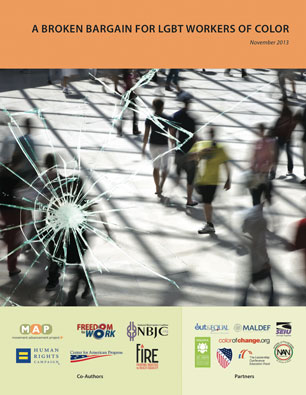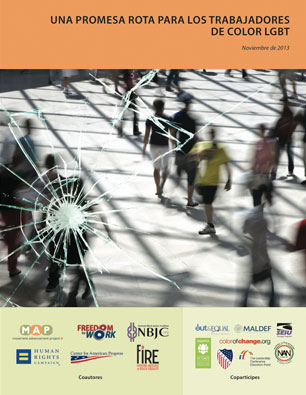The Bottom Line
The promise of the American bargain is that people who work hard will be judged and rewarded based on their contributions and capabilities—no matter who they are, what they look like, or where they are from. Instead of having a fair chance to get ahead, for LGBT workers of color in America, this bargain is in tatters.
A Broken Bargain for LGBT Workers of Color examines how LGBT workers of color face unique challenges related to their race and ethnicity and their sexual orientation and/or gender identity. In particular, LGBT workers of color are hindered by three major barriers: educational barriers; hiring bias and on-the-job discrimination; and unequal pay, benefits, and taxation. As a result, LGBT people of color are some of the most disadvantaged workers in the United States—and face extraordinarily high rates of unemployment and poverty.
The report offers detailed recommendations for action to fix the broken bargain for LGBT workers of color, including recommendations for federal, state and local governments, as well as schools, universities, and employers.
A Broken Bargain for LGBT Workers of ColorDownload
Recommended citation:
Movement Advancement Project, Center for American Progress, Human Rights Campaign, Freedom to Work, and National Black Justice Coalition. November 2013.
A Broken Bargain for LGBT Workers of Color. https://www.lgbtmap.org/workers-of-color (date of access).
Una promesa rota para los trabajadores de color LGBT
Los trabajadores de color lesbianas, homosexuales, bisexuales y transgénero (lesbian, gay, bisexual and transgender, LGBT) se encuentran entre los trabajadores de Estados Unidos que tienen mayores desventajas. Debido a la discriminación y junto con la falta de protecciones en el lugar de trabajo, las inequidades en los beneficios laborales y la carga impositiva y escuelas con bajos recursos de EE. UU., las personas de color LGBT enfrentan tasas extraordinariamente elevadas de desempleo y pobreza.
Una promesa rota para los trabajadores de color LGBT cuenta con la autoría conjunta de Movement Advancement Project (MAP), Center for American Progress (CAP) y su FIRE Initiative, Freedom to Work, Human Rights Campaign (HRC) y National Black Justice Coalition (NBJC), en asociación con Color of Change, League of United Latin American Citizens (LULAC), Leadership Conference Education Fund, Mexican American Legal Defense and Educational Fund (MALDEF), National Action Network, National Queer Asian Pacific Islander Alliance (NQAPIA), Out and Equal Workplace Advocates y SEIU.
Una promesa rota para los trabajadores LGBT ofrece recomendaciones detalladas sobre acciones para reparar la promesa rota para los trabajadores de color LGBT de parte de los gobiernos locales, estatales y federales, así como para escuelas, universidades y empleadores.
Una promesa rota para los trabajadores de color LGBTDescargar



